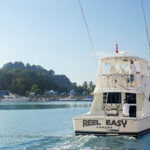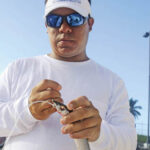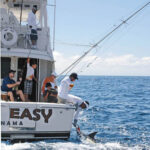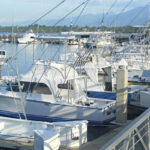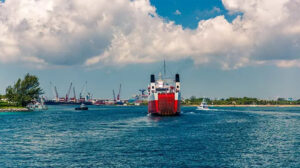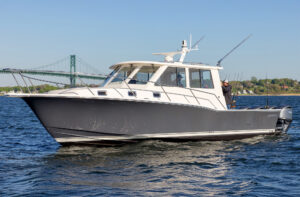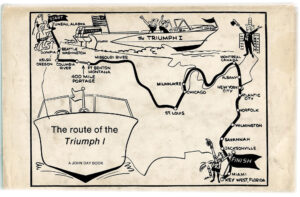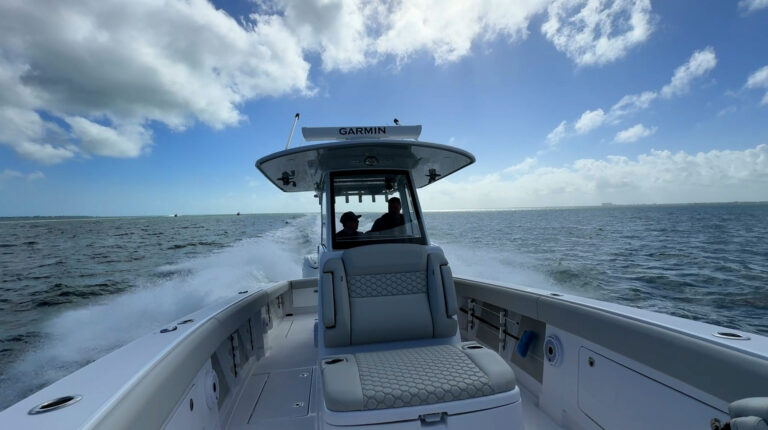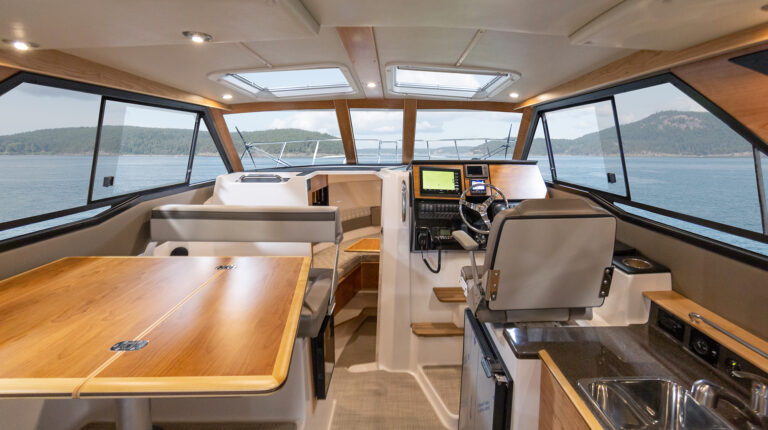Photos by Kanutto Fuentes
Blame It on the Sun
Off Costa Rica’s Marina Pez Vela, an Indo-Pacific sailfish puts the “trip” in fishing trip.

Photos by Kanutto Fuentes
The author battles one of the many large billfish caught off Quepos, Costa Rica, on a recent trip. The only thing hotter than the sun was the action.
I think I’m, like, smack in the middle of the jungle,” I said into my cell phone, checking in for the night with my girlfriend after a full day spent hopscotching through the Western Hemisphere. I had started out in New York, and from there flown to Miami, then on to San Jose, Costa Rica, and had finally been driven three hours on a dark and flood-prone rural road, all to get to the sleepy Pacific Coast town of Quepos. And I had just walked into my hotel room at the Si Como No resort, a small group of cottages nestled atop a steep hill and all but swallowed by dense rainforest. At night, the hotel is pitch black due to a dearth of lights perpetrated by its owner’s (and seemingly nearly everyone else in Costa Rica’s) eco-mindedness. As I groped like a blind man across the room towards a curtained, panoramic window which I could just make out in the low light, I wasn’t quite sure what I had gotten myself into. When I gingerly pulled open the curtains, all I saw was the kind of dense, bottomless darkness that must have spawned the phrase “fear of God.” “Yeah,” I affirmed into the phone, “it must be jungle out there as far as you can see.”
The next morning I awoke early and unusually refreshed and ambled back over to the window to see the previously unseen. I flung open the curtain, and I’ll never forget it—my jaw dropped. I was on a vista overlooking the mighty Pacific, an azure sky starkly contrasted against the steel-gray ocean. In the middle distance, a fist of island punched up out of the water, so densely vegetated it looked like a Chia Pet gone to seed. In the trees right in front of me small monkeys leapt back and forth screeching at one another—and what was that? To my right a prehistoric-looking thing that looked like a cross between a piglet and a deer scuttled off into the undergrowth. And all I could say was, “Whoa.”
I was in Costa Rica to visit Marina Pez Vela (pez vela means sailfish in Spanish), a full-service marina with high-end condos and a luxury shopping area under construction that has its hopes set on becoming a Mecca for boaters and sportfishermen alike. And it being February, I was in luck—it was sailfish season. Thirty-five miles out, probably just beyond where I could see from my hotel, the continental shelf broke off into deep water, creating a purported fisherman’s paradise where giant Indo-Pacific sailfish—a significantly larger subspecies than their Atlantic Ocean cousins—gorged on dense wads of bait and free-jumped from the cerulean waters for reasons known to no one but themselves.
I was pumped to catch one of these things as well as maybe one of the species of marlin that populate the same waters. In my excitement I could be forgiven if—as the boat chugged from the docks in the early morning hours of our first day of fishing—I seemed somewhat disinterested when a marina employee pointed out the marina’s cofferdams, a sturdy chain of cement monoliths encircling the development. “Those things are 38,000 tons a piece and built to withstand a 7.5 earthquake or a hundred-year storm,” the employee bragged. “We wanted them because they’re the biggest and baddest way to protect the boats in the marina.” At the time, I dutifully made note of the coffers—thinking them a bit on the macho-overkill side—and retreated to my seat on the gunwale. But in retrospect, after the tsunami in Japan and all the other recent turmoil in the natural world, I can’t help but think that having your boat under the aegis of such colossal brawn may well be wise.
After about an hour we reached the fishing grounds, dropped in our lines, and began to wait as the boat trolled steadily through the swells in S-shape patterns. Giant rays burst from the water off our bow and flopped back down in graceless freefall. A pitiless equatorial sun screamed down on our heads as the mates—Carlos and Gabriel—took cover behind silky balaclavas, calling to mind Sandinista fighters as they scanned the water’s surface relentlessly for signs of our prey. And still, we waited. As the morning slid toward noon the mates began to fidget. The captain, Reymond Rodriquez, seemed nervous as well, routinely calling in the baits and zipping over to fresh patches of ocean. In the distance, other sportfishing boats poked lazily along, even from afar their anticipation palpable on a near-windless sea.
The first fish hit with the urgency of a firefight, and the boat was instantly ablaze with frenetic action. The captain saw it first, the fish closing on the bait with lethal athleticism. “Tea-sirs! Tea-sirs! Tea-sirs!” he roared from the flying bridge as the fish approached, his otherwise impressive English losing its polish in the heat of the moment as he violently cranked in the teaser lines. The mates shot from their respective spots on the gunwales like two NFL defensive tackles bursting off the line. One set the hook as the other fitted me with the fighting belt, and then I began to reel. And reel.
The fish dove immediately after taking the bait, and we weren’t sure what was on the other end of the line at first, though I knew sailfish usually range between 100 and 120 pounds and whatever was down there fighting for its life felt heavier than that. For a brief moment, the tug on the line abated. Instantaneously from above came the captain’s shouts, “Reel! Reel! Reel! Here he comes!” The striped marlin rocketed across the ocean’s surface like a runaway submarine, a thin sheen of smooth seawater rushing up over its head as the crew exploded in cheers. “Two-hundred pounds, easy!” shouted someone. I was sweating in the thick afternoon heat as I reeled, but I couldn’t stop grinning through clenched teeth. Then suddenly, having spent all of its pop in the initial charge, the fish relented, and I hauled him boatside for our first catch.
Landing that first marlin was cool, but what I really wanted to do was catch a sailfish. With an all-out speed of 68 mph, it’s the fastest swimming thing in the world and considered by many to be the ultimate big game fish. However, with five other guys onboard who were now ahead of me in line to catch the next fish, I wasn’t sure if I’d get a chance that day.
My doubts soon quieted as the fish began to chew. Within a few hours everyone onboard had landed either a good-sized sailfish or, in one case, a black marlin approaching 300 pounds. And now it was my turn again. From the gunwale I gazed sternly out over the glittering ocean, as if I had any chance of spotting a fish before the skilled crew, who now stood side-by-side like sentries at the transom.
My sailfish hit the hook like a dart slamming into a dartboard, and the cockpit again exploded with cheers as the fish launched seven feet straight up in the air. “It’s a jumper!” yelled the captain, hoarse now. He wasn’t lying. The fish was a true acrobat and must have pulled out every trick in its repertoire to try and shake free. It repeatedly tail-walked back and forth across the water’s surface like some piscine MC Hammer, moving so fast it looked like someone had hit fast forward on the remote. At one point it ducked over to our starboard side, shot up to the surface, and thrashed its head in the air, its vaguely sentient eye brimming with an emotion somewhere between indignant rage and mortal terror. Then it dove, zipping around the stern with astonishing speed, the line crackling through the water. “Holy…” I muttered, reeling furiously to pick up the slack. But the slack kept coming as the fish boomeranged up from the depths at a near 90-degree angle to the seafloor, very close to the stern, its powerful tail driving aside great swaths of water, its sail rigid in defiance. Nearer the surface it rushed, from black water into the greenish murk where the sunlight pierces the abyss, and then it erupted from the surface like a missile, its lithe, nearly nine-foot-long body climbing higher and higher into the air not 15 feet off our stern.
Time slowed down for me as the fish reached its zenith, its body now perfectly parallel to the water. The sailfish was a shard of iridescence in the clear air, all acute angles and brilliant blues and greens. Again I saw its eye—this time much calmer than before, and glinting almost as if it were smiling. The animal hung there for one surreal moment, frozen in time and space, our eyes intently locked. Then its mouth began to move—and it spoke. “Not today, muchacho,” seethed the fish, an instant before breaking free of the line and torpedoing off into the deep. From behind me, cries of dismay rang out from my companions, each one laying out in greater and greater detail how close I had come to landing that beautiful fish. But standing flush against the transom, the rod now light in my hands, my jaw still slack, all I could say in return was “Whoa.”
Marina Pez Vela
(866) 739-8352.
(506) 2774-9000 (Local).
This article originally appeared in the December 2011 issue of Power & Motoryacht magazine.


